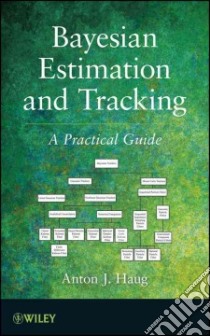Bayesian Estimation and Tracking - 9780470621707
Un libro in lingua di Haug Anton J. edito da John Wiley & Sons Inc, 2012
- € 133.70
- Il prezzo è variabile in funzione del cambio della valuta d’origine
"This book presents a practical approach to estimation methods that are designed to provide a clear path to programming all algorithms. Readers are provided with a firm understanding of Bayesian estimation methods and their interrelatedness. Starting with fundamental principles of Bayesian theory, the book shows how each tracking filter is derived from a slight modification to a previous filter. Such a development gives readers a broader understanding of the hierarchy of Bayesian estimation and tracking.Following the discussions about each tracking filter, the filter is put into block diagram form for ease in future recall and reference. The book presents a completely unified approach to Bayesian estimation and tracking, and this is accomplished by showing that the current posterior density for a state vector can be linked to its previous posterior density through the use of Bayes' Law and the Chapman-Kolmogorov integral. Predictive point estimates are then shown to be density-weighted integrals of nonlinear functions. The book also presents a methodology that makes implementation of the estimation methods simple (or, rather, simpler than they have been in the past). Each algorithm is accompanied by a block diagram that illustrates how all parts of the tracking filter are linked in a never-ending chain, from initialization to the loss of track. These filter block diagrams provide a ready picture for implementing the algorithms into programmable code. In addition, four completely worked out case studies give readers examples of implementation, from simulation models that generate noisy observations to worked-out applications for all tracking algorithms. This book also presents the development and application of track performance metrics, including how togenerate error ellipses when implementing in real-world applications, how to calculate RMS errors in simulation environments, and how to calculate Cramer-Rao lower bounds for the RMS errors. These are also illustrated in the case study presentations"--
Informazioni bibliografiche
- Titolo del Libro in lingua: Bayesian Estimation and Tracking
- Sottotitolo: A Practical Guide
- Lingua: English
- Autore: Haug Anton J.
- Editore: John Wiley & Sons Inc
- Collana: John Wiley & Sons Inc (Hardcover)
- Data di Pubblicazione: 19 Giugno '12
- Genere: MATHEMATICS
- Argomenti : Bayesian statistical decision theory Automatic tracking Mathematics Estimation theory
- Pagine: 369
- EAN-13: 9780470621707


